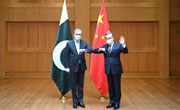Video:Decoding Belt and Road from a cultural perspective
Speaking of the “One Belt” (Silk Road Economic Belt), there is a long story behind it. In the Western Han Dynasty (206 B.C.-A.D. 24), in order to develop close relations with “neighbors” in the Western Regions (a Han Dynasty term for the area west of Yumenguan, including what is now Xinjiang and parts of Central Asia), Emperor Wudi decided to send an ambassador to carry out an inspection. A warrior named Zhang Qian volunteered for the mission.
Zhang’s two adventures to the Western Regions broadened the Chinese sense of geography, directly promoted material and cultural exchanges between China and countries in the area, and officially started friendly exchanges with western European countries.
More than 1,000 years later, Zhu Di, a similarly adventurous emperor of the Ming Dynasty, sent a 208-ship fleet led by Zheng He to visit countries overseas so as to further strengthen ties with them.
It is really amazing to compare Zheng He, the earliest intercontinental navigator in a real sense, with other, more famous navigators like Christopher Columbus, Vasco da Gama and Ferdinand Magellan. Zheng’s intercontinental voyages were decades earlier than these navigators who have been credited with the “Great Geographical Discoveries”! The maritime Silk Road Zheng exploited was definitely a remarkable achievement in the world at that time!
Today in the 21st Century, economic and cultural exchanges among countries along the ancient Silk Road and Maritime Silk Road are continuing and thriving in new forms and manners.
Six years ago, the first China-Europe regular freight train route ——“YUXIN’OU”(Chongqing-Xinjiang-Europe) came into use in Chongqing. Nowadays there are 17 such routes.
The 1,400-seat Algiers opera house, which was donated and built by China, is one of the best venues for the performing arts in Algiers, capital of Algeria.
Nationally acclaimed Indian craftsman Iqbal once found his craftsmanship of bracelets-making losing appeal at home. Thanks to the new-found access to the Chinese market, however, he is now hopeful it will live on and thrive.
There are, of course, many examples like these.
In 2013, Chinese President Xi Jinping proposed the “Belt and Road” initiative. As an old Chinese saying goes, “Appreciate the culture of others as one does to one’s own, and the world will become a harmonious whole.” The initiative comes from the depth of history with the genes of the 5,000-year-old Chinese civilization as well as the common wishes of peoples all over the world.
On May 14, the “Belt and Road Forum for International Cooperation” will begin in Beijing, capital of China, and 28 heads of state and government will gather here.
Checkout this video presented by GMW.CN(China).
Editor: Qiu Xueying
[ Editor: Xueying ]











More From Guangming Online
Medics from Fujian leave for Shanghai to aid in battle against COVID-19 resurgence
New int'l land-sea transport service to Indo-China Peninsula launched
Another makeshift hospital under construction in Shanghai
Tourists view tulips in Suiping County, Henan
In pics: blooming gagea flowers on grassland in Zhaosu, Xinjiang
Greek workers stage 24-hour general strike over high prices